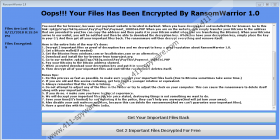RansomWarrior 1.0 Ransomware Removal Guide
Cyber criminals develop malicious applications every day, and it does not seem that they are going to stop. RansomWarrior 1.0 Ransomware is the newest ransomware infection developed by hackers from India. Despite being a new threat, it acts as an ordinary ransomware infection. Once it gets a chance to affect the computer, it immediately does that and locks discovered personal data. This is nothing very new – all ransomware infections try to obtain money from users one way or another. RansomWarrior 1.0 Ransomware should encrypt music, documents, pictures, and many other files on affected computers. If undesirable changes have already been made on your computer, you should delete this threat from your system right away so that it could not affect more files. Of course, you should not erase this infection if you are going to purchase a decryption key from cyber criminals. In this case, you should keep it until you unlock your files. We cannot promise that these files will not be encrypted again, or the decryption tool will fix all your files, so it would be smart to restore affected files using an alternative file retrieval method, e.g. to restore files from a backup.
RansomWarrior 1.0 Ransomware is a typical ransomware infection, so the first thing you will notice if it ever slithers onto your computer is a bunch of locked files. Names and original extensions of these files will be changed, but it will not be complicated at all to recognize encrypted files because they all get the same .THBEC extension. As for the file’s name, it is changed to Encrypted{ID}. For example, a file picture.jpg may become Encrypted2.THBEC. Users who encounter RansomWarrior 1.0 Ransomware should also find a window with a message opened on their Desktops. It contains a long message, but the essence of it is that only a decryption key can unlock files. Do not expect to get it from cyber criminals for free. It can only be purchased from them. At the time of analysis, the ransomware infection demanded 349 USD, but the decryptor’s price may vary. You should not purchase this tool no matter how much it costs because nobody knows whether it will really be given to you. Even if you get it, it may not work, so you should take time to consider whether it is worth purchasing it. It does not necessarily mean that your files will stay locked if you do not acquire it. You could still restore them from a backup. Also, researchers say that RansomWarrior 1.0 Ransomware is decryptable, meaning that files it has locked can be fixed. An automated decryptor was unavailable at the time of writing, but since the threat is decryptable, it should not take long for a free decryption tool to be released.
Researchers have not only found out how RansomWarrior 1.0 Ransomware acts, but they can also now say how this infection is distributed. According to them, this infection should be mainly distributed via spam emails, so if you ever receive an email from an unknown company or a person, you should not hurry to open an attachment it contains. There is a huge possibility that the attachment is malicious, i.e. contains malicious software. Malware is often spread via emails, but it is not the only distribution method that exists for sure, so you cannot surf the Internet unless you install reliable security software. Of course, it does not mean that you could act completely carelessly on the web after the installation of an antimalware scanner. You might end up with malware even after you clicking on a decent-looking link found on a random website.
If your files have already been encrypted by RansomWarrior 1.0 Ransomware, you could access them again only if you unlock them. As mentioned, a decryptor can be purchased from the ransomware author, but you should not buy it, in our opinion. The ransomware infection is decryptable, so it is very likely that free decryption software will be released in the near future. No matter what you decide to do, do not forget that RansomWarrior 1.0 Ransomware will not be erased automatically. You have to take care of it yourself. Feel free to use our below-provided instructions.
Delete RansomWarrior 1.0 Ransomware manually
- Press Ctrl+Shift+Esc.
- Access Processes.
- Locate the malicious process with the description RansomWarrior 1.0.
- Right-click on it and select Open File Location.
- Kill the malicious process.
- Delete the malicious file in the opened directory.
- Empty your Recycle Bin.
RansomWarrior 1.0 Ransomware Screenshots:

RansomWarrior 1.0 Ransomware technical info for manual removal:
Files Modified/Created on the system:
| # | File Name | File Size (Bytes) | File Hash |
|---|---|---|---|
| 1 | Date_Happened.THBEC | 1 bytes | MD5: c4ca4238a0b923820dcc509a6f75849b |
| 2 | Number_Of_Encrypted_Files.THBEC | 1 bytes | MD5: 45c48cce2e2d7fbdea1afc51c7c6ad26 |
| 3 | DEX.THBEC | 21 bytes | MD5: f91a48324aeed7b3f5461111a5ecbe6a |
| 4 | FileNamesCrypted.THBEC | 1137 bytes | MD5: 9cd0effde380d4726aa024b29a9ff005 |
| 5 | KeyCrypt.THBEC | 7 bytes | MD5: ede42cd775f53e6dd2cce7b1f5e84e49 |
| 6 | FreeFileNamesCrypted.THBEC | 235 bytes | MD5: 7c9ed49914dd5d5b95135afda9b3f82d |
| 7 | Happened.THBEC | 1 bytes | MD5: c4ca4238a0b923820dcc509a6f75849b |
| 8 | TEX.THBEC | 21 bytes | MD5: fb26c2fd696d4f26ad5df0177dc2b252 |

